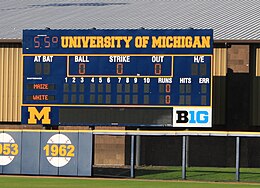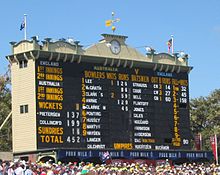Scoreboard
This article relies largely or entirely on a single source. (September 2020) |


A scoreboard is a large board for publicly displaying the score in a game.[citation needed] Most levels of sport from high school and above use at least one scoreboard for keeping score, measuring time, and displaying statistics. Scoreboards in the past used a mechanical clock and numeral cards to display the score. When a point was made, a person would put the appropriate digits on a hook. Most modern scoreboards use electromechanical or electronic means of displaying the score. In these, digits are often composed of large dot-matrix or seven-segment displays made of incandescent bulbs, light-emitting diodes, or electromechanical flip segments. An official or neutral person will operate the scoreboard, using a control panel.
Technology

Prior to the 1980s most electronic scoreboards were electro-mechanical. They contained
Scoreboards in various sports
North American football

In both the
Basketball

A
In some multipurpose venues where ice hockey and basketball are played, the scoreboard unit which shows penalties will be used to display the player on the court, number of fouls, and points scored in the game. The team fouls are usually placed in the same position as shots on goal in hockey games. In some university arenas, the scorer's table, which has traditionally been used for displaying physically scrolling advertising boards along its face, may also feature either a traditional mechanical scoreboard, or a scoreboard display within a LED display on the front of the table which also functions with virtual scrolling advertisements.
Since 1991, the NBA has mandated that each shot clock carry a duplicate readout of the time left in the period in addition to the shot time. Since 2011, the shot clock also shows tenths of a second past five seconds left on the shot clock. Many college and even some high-school shot clocks (in states where a shot-clock rule is in effect for high-school basketball) now also include a game timer.
Three-sided game shot clocks became a trend in the 1990s, and after a controversial series of calls during the
Daktronics has introduced a technology called ColorSmart, which denotes the trailing team's score numbers with red lighting, while the leading team is in green. However this technology has yet to be utilized in a game settings as the bylaws of the major basketball sanctioning bodies and many of the high school athletic bodies decree that both scores must display in the same color; the rule came into effect in 1994 after Spectrum Scoreboards introduced an earlier version of the concept. This is used almost exclusively in recreation leagues.
Baseball

For
Manually operated scoreboards are still found frequently in baseball, particularly at older venues. Well-known examples of manual scoreboards, using numbers painted on metal sheets hung by people working inside the scoreboard, include
In some stadiums since 2005, LED boards which are the full height of the outfield wall have been installed to either replace a manual scoreboard or enhance an existing wall, are considered in play, and are durably constructed to withstand the impacts of fielders colliding with the wall, along with the impact of a baseball against the panel. Examples of this type of scoreboard display are seen in
in Kansas City. In all three cases, the walls display the current game state of out-of-town games (often down to pitch count for the current at-bat and runners on base), statistics for the current batter or pitcher, and promotional messages.Another display has been added to minor and major league stadiums through the mid-2010s to the current day, the pitch clock, which will become a binding rule in MLB in the 2023 season. This is a separate display, analogous to the play clock in football, and has multiple iterations throughout the stadium for maximum player, coach, and umpire visibility, along with spectators. Outside of timing pitch releases, the pitch clock also displays time remaining before play resumes during a media timeout between innings, and to time warmup periods for relief pitchers coming out of the bullpen.
Cricket


For cricket a scoreboard will as a minimum display the batting team's score, wickets fallen, the opposition's totals. Most county-standard scoreboards will also display each batsman's score, overs remaining, extras, the bowlers currently on and details of the last wicket to fall. Australian state scoreboards will usually contain more detailed information.[2]
Ice hockey

An ice hockey scoreboard will at the minimum display the time left (in North America) or played (in Europe), the number of goals scored by each team as well as any penalties currently being served. Additional information such as shots on goal may be shown on smaller scoreboards located in the arena. Tenths of a second are usually displayed within the last minute of each period.
In multipurpose arenas, the penalties being served will appear in the multi-purpose panels, used for player statistics in basketball, with shots on goal in the same position as team fouls for basketball. In some arenas the sideboards of the hockey rink feature three or four LED displays the size of one advertising hoarding which will show scoring information and promotional messages, though their limited visibility makes them rarely used.
A horn or buzzer must be used to signal end of timeouts or period. In most games, the home team will either play a recording of or use a separate goal horn, usually an Airchime, Kahlenberg, or Buell when their team scores. These aren't required, but are rather used as a celebration, and they are often unique to their team and easily identifiable. A notable example would be the recording that the Boston Bruins play which is used by many other teams. [citation needed]
Motorsports

In auto racing, the scoreboard typically displays the running order of the race, and number of laps completed. Some more complex boards scroll statistics such as average speed, laps behind, and timing reports.
Rugby football
All codes of rugby football have a game clock, the number of tries, penalties, field goals and conversions listed.
Track and field
In track and field there is usually an elapsed time display. Sometimes the team scores are displayed. Often in higher levels there is a variable message display next to each field event area that displays the standings and who is up next. Other indicators may show track side wind speed. In some settings where a track surrounds an athletic field, a track and field scoreboard may be combined within the football scoreboards.
Association football
An
Some amateur and youth levels will have the clock count down.
Some American venues will use a multi-purpose gridiron/soccer venue type scoreboard where various statistics are shown. Such may include either total fouls, corner kicks, shots on goal, or other important statistics for spectators to learn their team's overall performance.
Softball
Similar to baseball, a softball scoreboard will at the minimum show both team scores and the current inning. In addition, the number of balls, strikes and outs, and the number of hits and errors are often indicated.
Swimming
The scores for the meet, swimmer by lane, and their current placing, along with their race times are displayed on this type of board. The time display is most often in
Wrestling
Wrestling scoreboards will display the team scores, the current match time, the match score, and the weight class. Some scoreboards may also display riding time.
Captioning requirements
Within the last few years most major league, professional and major college venues also include smaller displays featuring closed captioning of announcements from the public address system and advertisements displayed on the scoreboards to comply with the United States Americans with Disabilities Act of 1990 for the hard of hearing, and to allow distracted spectators to read what had been said.
Video board animation
Most major sports facilities will use a video board and display graphics and fun videos relating to what is happening in the game. For instance, a home run may be depicted by an animation of a ball flying out to space. These animations are usually high in detail and are customized for the team that uses them. Most Major League Baseball facilities do their video editing on site in the press box; however, at Triple-A baseball stadiums most of it is done off site. Some teams have animators that create their own animations, while others have outside companies do the work for them.[citation needed]
See also
References
- ^ "NBA, watchmaker Tissot announce multiyear partnership". ESPN. 5 October 2015. Retrieved 1 June 2023.
- ISBN 978-1-250-12020-5.
External links
![]() Media related to Scoreboards at Wikimedia Commons
Media related to Scoreboards at Wikimedia Commons
Example Online Scoreboard from Scoreboard.Rocks
